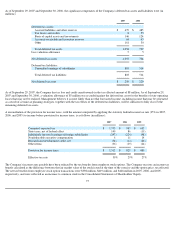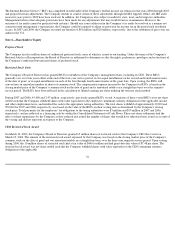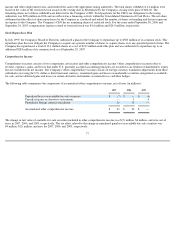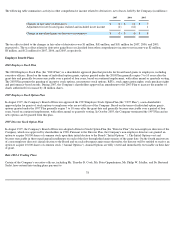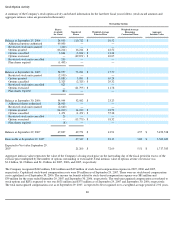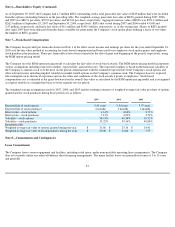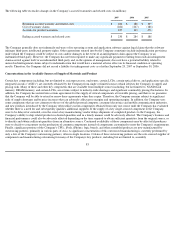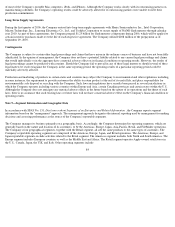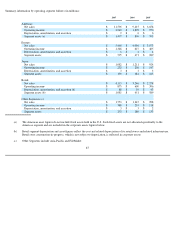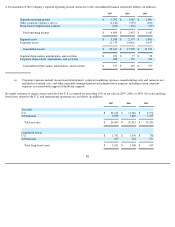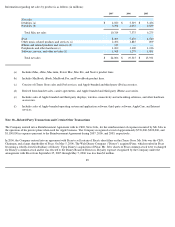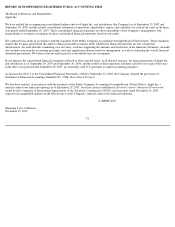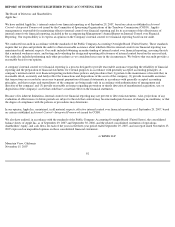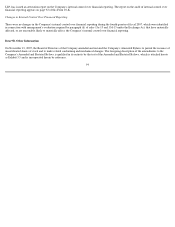Apple 2007 Annual Report Download - page 89
Download and view the complete annual report
Please find page 89 of the 2007 Apple annual report below. You can navigate through the pages in the report by either clicking on the pages listed below, or by using the keyword search tool below to find specific information within the annual report.
Asia-Pacific, which includes Australia and Asia except for Japan, and the Company's subsidiary, FileMaker, Inc. Each reportable geographic
operating segment provides similar hardware and software products, similar services and the accounting policies of the various segments are the
same as those described in Note 1.
The Company evaluates the performance of its operating segments based on net sales and operating income. Net sales for geographic segments
are generally based on the location of the customers, and net sales for the Retail segment are based on sales from the Company's retail stores.
Operating income for each segment includes net sales to third parties, related cost of sales, and operating expenses directly attributable to the
segment. Advertising expenses are generally included in the geographic segment in which the expenditures are incurred. Operating income for
each segment excludes other income and expense and certain expenses managed outside the operating segments. Costs excluded from segment
operating income include various corporate expenses such as manufacturing costs and variances not included in standard costs, research and
development, corporate marketing expenses, stock-based compensation expense, income taxes, various nonrecurring charges, and other
separately managed general and administrative costs. The Company does not include intercompany transfers between segments for management
reporting purposes. Segment assets exclude corporate assets such as cash, short-term and long-term investments, manufacturing facilities,
miscellaneous corporate infrastructure, goodwill and other acquired intangible assets, and retail store construction-in-progress not subject to
depreciation. Except for the Retail segment, capital asset purchases for long-lived assets are not reported to management by segment. Capital
asset purchases by the Retail segment were $294 million, $200 million, and $132 million for 2007, 2006, and 2005 respectively.
From the establishment of the Retail segment in fiscal 2001 through the quarter ended March 31, 2007, Company management assessed the
segment's operating performance differently from the Company's other operating segments. Because the Company's Retail initiative was an
unproven concept at inception, management chose to measure the Retail segment's performance in a manner that would allow comparability to
the Company's major channel partners operating retail stores in the U.S. There were three significant differences in the measurement of the
Retail segment's results relative to the Company's other operating segments. First, the Retail segment's operating income reflected cost of sales
for Apple products at amounts normally charged to Apple's major U.S. channel partners for the same products, less the cost of the Company's
sales programs and other costs to support those partners. Second, the cost of sales of the Company's service and support contracts, including the
AppleCare Protection Plan ("APP") and .Mac, were reflected in the Retail segment's results at the costs charged to major channel partners for
such contracts, and all associated revenue was reflected in the Retail segment's results at the time of sale rather than being amortized over the
lives of the respective agreements. Because the Company had not yet earned the revenue or incurred the cost associated with the sale of such
contracts, an offset to these amounts was recognized in other segments' net sales and cost of sales. Third, the Company allocated certain
expenses related to the operation of its high-profile stores to corporate marketing expense.
Having operated the Company's Retail stores successfully for more than six years, management believes its Retail initiative is a proven concept
that will continue to be an integral element of the Company's distribution and marketing strategies. Additionally, the Company expects sales of
iPhone by the Company's geographic and Retail operating segments to generate significant levels of deferred revenue and deferred cost of sales
over time. In consideration of these factors, management has determined that beginning with the quarter ended June 30, 2007, aligning
measurements for the performance of the Retail segment with those used for the Company's other operating segments provides the most
meaningful information. Accordingly, management has begun to measure the Retail segment's operating performance in a manner
85


